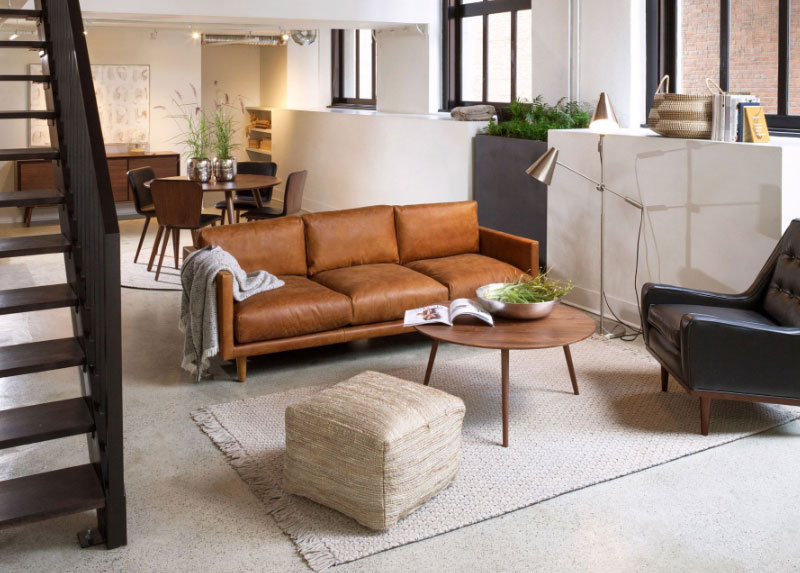Mid-century style is difficult to pin down. Some purists will say that the 50s and 60s were the only true period of mid-century decor, while others would include pieces from all sorts of periods in between. But what we do know is that this style draws heavily on the simplicity and clean lines of modernism — which we can see in everything from furniture to food and drink — with a lot more colour than you’d find in a typical white box apartment or actual home. The result is a sleek but surprisingly inviting aesthetic with an emphasis on things like materiality, function, and connection to nature; one where weighty materials like marble countertops are complemented by natural light filtering through expansive windows. We hope you enjoy this article on how to decorate with mid-century furniture.
What is Mid-Century Decoration?
The qualities that make the mid-century style so appealing include the idea of simplicity and clean lines, combined with a focus on function and a more natural aesthetic. Indeed, many of the best mid-century decor pieces are meant to mimic cheap, functional modern building materials like poured concrete, which is reflected in their often simple angular designs. The result is often an aesthetic that looks new even while paying homage to the past. Mid-century style was based on the idea that simple lines are beautiful and the use of natural materials like wood. The idea of mid-century design is simple, honest, and elegant.
In many ways, the mid-century decor is a throwback to earlier times in many cases, where people did things very differently from today’s standards. The other key quality is function, which we believe explains how mid-century decoration can be so appealing to modern tastes despite taking inspiration from simplicity and modernism. We think this rolls back to the idea that people could build their own furniture and furnishings without too much trouble; thus creating pieces that were both simple and capable of holding up for years after purchase.
How to decorate with mid-century furniture:
We’ve already touched on the idea of function as a key theme for mid-century decor. But how do you make this idea work for you? The first thing is to find pieces that will accomplish all your needs without sacrificing style and beauty.
Tip 1:
Let’s talk colour; this is where mid-century furniture becomes more unique than what many people first expect. Given its modernist roots, people often picture monochrome living rooms and white on white kitchens; but we think the natural materiality of use — such as the hardwood of a coffee table or the plastic-like finish of a chair — means that your furniture can take on many different colours and styles without looking out of place.
Tip 2:
Use wall coverings; the colours we’ve talked about so far should give you an idea of what we mean here. The mid-century decor features a lot of bold and geometric patterns that often completely cover the walls, complementing the simple but eye-catching furniture pieces. This is a great way to get your mid-century decor ideas on the walls, helping you use the same style throughout all parts of your home.
Tip 3:
Look for pieces that are scaled for easy storage; Many of the mid-century decor pieces are elegant but highly functional, which means that many are made to be easy to store and move around. This is why so many of them have great aesthetic appeal but are also still very sturdy.
Tip 4:
Think about the function of your furniture; This is a great tip for when you’re moving into a new place or simply want to rearrange for aesthetic purposes. A chair with exposed steel braces and exposed springs would look silly in a bathroom, but it might work well in an office or classroom — and doing so could make your workspace feel fresh and new.
The best ideas on Mid-century decoration:
It’s easy to get carried away with decorating when you’re just starting out, especially if you’re using mid-century furniture. But it’s important to realise there are some things that are great for mixing and matching, while others are best kept separate. For example, match your furniture to your existing style of decorating. A clean-lined minimalist piece will look out of place in a home that has a lot of ornate patterning. Instead, think about how the classic aesthetic can complement what you already have in place or follow the same design philosophy rather than attempting to copy each other exactly.
For instance, wooden furniture is an important part of mid-century decor, which is why it’s often one of the first styles you’ll come across when researching the style. Today, we use wood for so many things — from furniture to floors — that materials like plywood and composite plastics are now often hailed as rock stars of modern design.
Wooden chairs were very common in mid-century design, with elements like fabric covers and reclining backs helping pull together popular designs made with them. You’ll also notice that the colours of the furniture tend to reflect this love of wood, with wood-grain finishes often making an appearance. While you’ll still find some dark browns and purples, many mid-century furniture pieces look more modern and clean than what we first expect. Whites and other pastels were very common as well, with these colours often popping up on other objects like screens and lamps.
Conclusion
Finally, we need to mention just how timeless — yet modern — the best mid-century furniture pieces can be. Some of them were so popular that they remain as desirable as ever, which is one reason why you’ll see so many secondhand sales for them online.
Follow Home Inside for more!
